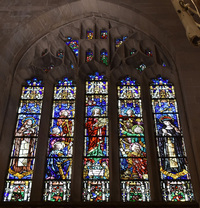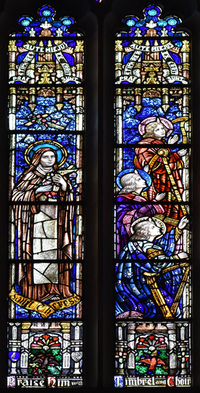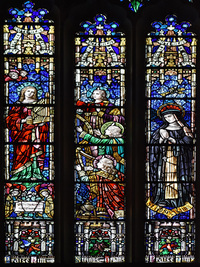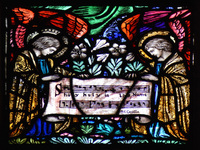Window
Building Name: Cathedral of the Most Blessed SacramentStudio Name: Willet Hauser Architectural Glass
City: Detroit
Window Shape: 6 (gothic arched, more than 2 vertical sections)
Subject/Title of Window: The St. Cecilia Window
Brief Description of Subject: The canopy of this window is decorated with praying angels.
At the top of each of the five lancets is the Biblical passage "Prae timore autem ejus exterriti sunt (custodies). It is Matt. 28:4 -- an angel has appeared at the tomb of the resurrected Christ "and the guards trembled in fear of him."
The scene uses the middle three lancets to describe the inscription from Psalm 150. St. Cecilia, playing a Medieval organetto and putti above her, is surrounded by wingless angels playing stringed instruments and one with a hymnal. That the music is praising the Lord is shown by the censer with smoke rising upwards to heaven in the 4th lancet ---- Psalm 140 (Douay-Rheims) "Let my music be directed as incense in thy sight". The page of sheet music contains the words "holy holy is this Name" signed "St. Cecilia". The outer lancets show Saints Theresa and Rose facing inwards toward the musicians. Below the scene, between the columns, can be seen songbirds.
St. Theresa of Lisieux (1873-1897) with permission from the pope, was able to join the Carmelites at an early age and took the name "Theresa of the Child Jesus and the Holy Face". She wrote her autobiography entitled "Story of a Soul" which was published two years after her death and took the Catholic world by storm. The rose became her attribute based on a quote from that book "When I die, I will rain down roses (from heaven)." This pose of St. Theresa is based on a drawing by her sister in 1919.
St. Cecilia (3rd Century) became the patron of singers and musicians based on a story that took place on her wedding night that was written in a book called the "Golden Legend" (13th Century) -- "and she hearing the organs making melody, she sang in her heart, only to God."
St. Rose of Lima (1586-1617) was born with the name "Isabella" but because of her great beauty was called "Rose". She joined the Dominican Order and took the name "Rosa de Santa Maria". She lived a life of penances and suffering. She would fast, wear hair shirts, and put a crown of thorns on her head. She is seen here costumed as a Dominican nun, wearing a crown of roses, praying the rosary, and a crucifix above her head.
From the Guide to the Cathedral of the Most Blessed Sacrament, Copyright 1958, Archdiocese of Detroit.
Here represented is the beatification of St. Cecilia, one of the most widely revered saints of the early Church. Along with her princely husband, she suffered martyrdom in the third century. Patroness of church music, she appears here with an organ. With uplifted face she listens in rapture fo the heavenly chorus while on both sides the angelic host come with harps of gold to join in her song. On one side can be seen St. Therese, the “Little Flower”, in the habit of the Carmelite Sisters. In her hands she holds the cross entwined with roses and passion flowers. On the opposite side we see St. Rose of Lima, born in Peru of noble Spanish-American parents. Beneath the chaplet of flowers that adorned her head, she always wore a crown of thorns that pierced her flesh. In the smaller panels beneath this window are two angels holding a musical scroll with songbirds to the right and left. In the traceries above are smaller angels playing upon musical instruments. The text panel is from Psalm 150: “Praise the Lord in His holy ones.”
Inscriptions: (Douay Rheims Psalm 150:4-5)
Praise Him with Timbrel and Choir
Praise Him with Strings and Organs
Praise Him
Height: 11'
Width: 10'
St. Cecilia
St. Cecilia, left
St. Cecilia, right
St. Cecilia, hymn
The MSGC is a constantly evolving database. Not all the data that has been collected by volunteers has been sorted and entered. Not every building has been completely documented.
All images in the Index are either born-digital photographs of windows or buildings or are scans of slides, prints, or other published sources. These images have been provided by volunteers and the quality of the material varies widely.
If you have any questions, additions or corrections, or think you can provide better images and are willing to share them, please contact donald20@msu.edu






